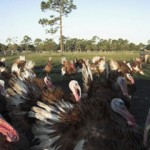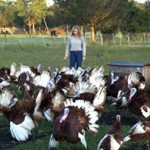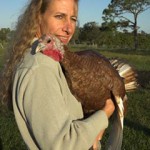Education: Florida Small Farms Conference
- Crazy Hart Turkeys
- At Crazy Hart Ranch, Linda and Turkeys
- Turkey Hen w/ Linda @ Crazy Hart Ranch
Last weekend I went to Kissimmee Florida for the Florida Small Farms Conference. I was one of 800 registered attendees.
Saturday morning the opening address was given by the Florida’s Department of Agriculture and Consumer Services Commissioner Charles H. Bronson. I was glad to hear him speak because it made me realize that those things about which I worry are also concerns for some officials in our local government. My impression was that Mr. Bronson is acutely aware of how tenuous our industrial farm food supply system is. He spoke of his hopes that small farms in this state would be able to grow into the primary food suppliers for Florida’s millions. That is what I hope too. Especially after eating two excellent breakfasts and two fabulous lunches at the Florida Small Farms Conference provided by Florida’s local farms and ranches, and prepared by excellent local chefs. We ate all kinds of vegetables including black eye peas and okra, squash, and corn, sweet potatoes and white potatoes, carrots, pearl onions, collard greens, green salads and tomatoes, mangos and blue berries and locally grown honey! We also had farm raised beef, roast pork, goat, lamb, rabbit and chicken The chicken served at Sunday’s lunch came from our friend Linda Hart’s Crazy Hart Ranch. At breakfast eggs were offered with potatoes and onions, goat sausage (my favorite), bacon, drinkable yogurt, Orchid Isle orange juice, dairy fresh milk, pastries, bagels and lots of fruit including huge bowls of longans, as well as tea and organic coffee.
Although there was plenty of food for over 800 people for the whole weekend conference, right now there aren’t enough small farms and ranches in Florida to produce enough food for Florida’s over 18 million residents. New farms are starting up pretty regularly now though, and not because the work is easy or even very lucrative, but because the work is meaningful, and the view from the office window is spectacular!
One serious problem that small ranchers have in Florida is that there are very few processing plants certified by the USDA for slaughter as well as cut and wrap operations. Several processors are certified by the USDA for slaughter, but not for cut and wrap operations. What that means is that meat processed in a plant that doesn’t have the USDA cut and wrap certification can not be sold to the public. Right now ranchers who want to sell their meat to the public must transport their livestock, often hundreds of miles, to a qualified processor with both USDA certifications, leave, and then drive back again a day or so later to pick up the meat once it is processed and frozen. The more commonly chosen option is to sell an individual livestock directly to the client, even dropping the live animal off at the USDA certified for slaughter only processor for the client, and then the individual client does business directly with the processor to have the livestock slaughtered, cut and packaged for the home freezer. This can work out fine if a few families are sharing in this meat order. It is best to allow the rancher to choose which processor to use.
Giant confined animal feeding operations (CAFOs) get around these difficulties by creating their own USDA certified processing plants on the factory site. I don’t know about you, but I don’t care to eat meat from confined animal feeding factories and their processing plants. Think about what confinement means for an animal. It is no wonder CAFO processing plants are constantly battling with e coli and salmonella bacteria. I make a stand against this at the cash register, or more specifically, at the green market where I spend my bucks on pastured poultry and eggs from a small ranch operator.
Small meat producers are very different than their CAFO counterparts. Small ranches raise their livestock on pasture where they graze on pasture grasses, live and walk beneath the sky, and hang out in the cool shade under trees. Some sustainable ranchers and farmers are practicing pasture rotations so that livestock move to fresh pasture daily reducing the risks of parasitic infestations, and increasing the nutrient value of the pastures grazed. While grains and feed mixes may be offered they are not the only feed for pastured livestock. A primarily grass diet for livestock has a profound effect on the nutrient values of the meat, increasing HDL (good) cholesterol, while reducing LDL (bad) cholesterol, and increasing antioxidants. Beef Ranchers who want to call their cattle USDA Grass Fed Beef must keep the cows fed on a diet of only grasses in the vegetative state, (once it goes to seed it is grain) and or hay and silage, and even the pregnant cow must be only grass fed prior to the birth of the calf which will be fed on grass only once it is weaned. If because of weather or other emergencies it is necessary to keep the cattle alive on grains the occasion should be well documented. It is more lucrative to raise grass fed beef. People who want it will pay a premium price for grass fed beef. Right now it is considered a gourmet business, but I hope it will catch on and go mainstream.
Grains help put fat on cows, turn the color of the fat from yellow to white, and will make the beef more tender, but cows have trouble with the pure grain diets of the feed lots, their stomachs are made for digesting grasses. Corn in grain diets is too high in sugar and those sugars can cause illness and infections, so in the feed lots, right before the beef will begin its journey to your dinner plate the cows are dosed on antibiotics to keep the corn in their stomachs’ from killing them. Wow! That’s Gross! Oh yeah, need more grossness? The cows are wall to wall cows on the feed lots sick and dosed on antibiotics, all standing and lying in shit, their hides full of feces right before going to slaughter and processing. All the bleach and disinfectant in the world doesn’t keep some e coli from traveling with meat that came from such places.
The most profound difference in meat from a small ranch setting is that the livestock is given a life outdoors in space and some respect for basic needs is given to the livestock, as part of creation and as a life for which we are grateful.
A vegan friend once told me that she couldn’t eat anything with a face. I can not eat anything with a sad face. It may sound silly to some but I am perfectly serious when I say I expect a humane and satisfying existence for any creature I am going to consume, and I couldn’t have even imagined that a person would have to say such a thing not too many years ago. Once upon a time I didn’t know about Confined Animal Feeding Operations. For years I ate grocery store and restaurant meat thinking I was eating fresh and making good choices. Now my eyes are open. Now I shop better, not only for the health of my family, but for the health of our nation and our small farms. Things are going to change. It is high time for us to develop mutually beneficial relationships with small farmers and ranchers. This is just another step in the right direction, another thing we can do to help our communities and our mother earth.
Next up: Education: Florida Small Farms Conference, Part II
Now go out there, meet a small ranch owner, and save the world!




3 Responses
I really like what you wrote about eating meat from happy faced animals! I know we just found our own healthy, local meat source. What a difference.
Right on Sara! Thanks for your comment.
Sounds like a great trip.